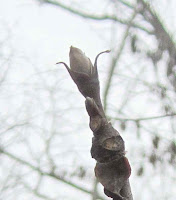 |
| Water and ice |
In the depths of winter, the height of the season, the weather often follows
a rollercoaster cycle: freeze, thaw, and freeze again. The January thaw is a
recognized meteorological phenomenon around here. This year we’ve had several
thaws, with stretches of single-digit nights between them.
The climate here in the middle of the continent depends on the weaving
of cycles thousands of miles away. Mild air from the Pacific rolls in
regularly. Sometimes it brings rain or wet snow. It also traps Arctic air in
the north, building up until it looms over Canada like a glacier. Outbreaks of
polar cold come roaring down across the plains. Road crews and TV weather
forecasters shift into high gear.
 |
| Moss and snow |
After snow, the warming air melts the earth into mud. When the deep
freeze starts again, dirt turns solid. Deer tracks are set in stone. With the
next thaw, the soil becomes powdery earthbound dust. This is the pattern that
transforms rock into topsoil, crack by tiny crack. Gaia recreates herself each
winter, with each grain of earth.
I walk in the woods every chance I get. The rare 60-degree days are
gifts from spring, but I walk farther on cloudy days that never get above 40.
My world is transparent in winter. I can see through the trees to the road at
the foot of the hill, a neighbor’s barn, the bright surface of a lake in the
valley.
 |
| Hickory bud |
Hickory and oak trees make gray buds. Red twigs brighten at the tips of
dogwood trees. Black clusters form where seedpods attach to redbud branches. This
year the first snowdrops bloomed on Twelfth Night. The woods are getting ready.
A Scottish legend says that the Goddess Brighid grows old and bent and gray as the rocky hills with the season. At the start of February she strikes a stone with her staff
and releases a flowing spring. She drinks the living water and becomes young again, as lambs begin to be born and flowers spring from the ground.
In the next thaw, I will dig a little hard soil from my garden and put
it in a pot. I will water it and set it beside my wood stove. As it warms with the
year, we will move toward spring.
 |
| Snowdrops |




